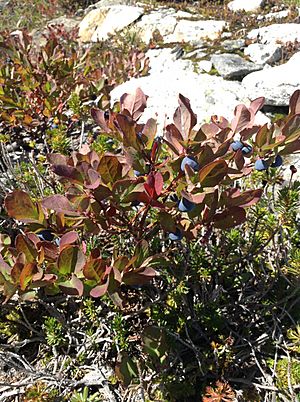Cascade bilberry facts for kids
Quick facts for kids Cascade bilberry |
|
|---|---|
 |
|
| Vaccinium deliciosum full plant | |
| Scientific classification | |
| Genus: |
Vaccinium
|
| Species: |
deliciosum
|
The Cascade Bilberry, also known as the Cascade Blueberry or Blueleaf Huckleberry, is a special type of bilberry plant. Its scientific name is Vaccinium deliciosum.
This plant grows naturally in western North America. You can find it from British Columbia in Canada all the way down to northern California in the United States. There are also some small groups of these plants in eastern Idaho.
Cascade Bilberries like to grow in high places, usually between 600 and 2,000 meters (about 2,000 to 6,500 feet) above sea level. They live in cool, mountain areas like coniferous forests, open meadows, and clearings.
Contents
What Does the Cascade Bilberry Look Like?
The Cascade Bilberry is a shrub that grows in clumps. It has stems that spread out and can root (grow new roots) when they touch wet ground. This means one plant can spread and form large patches!
The new branches are green, smooth, and a bit waxy. The leaves grow in an alternating pattern along the stem. They are thin and oval-shaped, usually between 1.5 and 5 centimeters (about 0.6 to 2 inches) long. Their edges are mostly smooth, but sometimes they have small teeth near the ends. These leaves fall off in the autumn.
Flowers and Berries
The flowers grow one by one where the leaves meet the stem. Each flower is about 6 or 7 millimeters long and shaped like a wide urn. They are a pale pink color.
The fruit is a round berry that can be waxy blue or reddish. It often has a powdery coating on it. These berries can be over a centimeter (more than 0.4 inches) wide. Many people say they are especially delicious!
Sometimes, the Cascade Bilberry can be confused with another plant called Vaccinium caespitosum. This other plant grows in wetter areas in the same region. A good way to tell them apart is that V. deliciosum has a powdery coating on the underside of its leaves, while V. caespitosum does not.
How Does the Cascade Bilberry Survive in the Mountains?
The Cascade Bilberry has special ways to live in places with short growing seasons, like mountains. These seasons can be as short as three or four months.
From late autumn to spring, the plants depend on snow to keep them warm. The snow acts like a blanket, protecting them from very cold temperatures. If there's a hard frost (below -4 degrees Celsius or 25 degrees Fahrenheit) without snow cover, the flowers can get damaged, and the plant's growth can slow down.
However, these plants also need a period of freezing temperatures for a few months. This "chilling" period helps them get ready to flower when spring arrives.
Why Are Cascade Bilberries Important?
The berries from the Cascade Bilberry are a very important food source in mountain areas. This is especially true in very high places where there aren't many other edible plants.
Food for Animals and People
Many animals love to eat these berries, including black bears, birds, mice, and chipmunks. Rabbits and deer also munch on the plant's leaves.
Humans also enjoy these berries a lot because of their super sweet taste. You can eat them fresh, dry them, or cook them in different dishes.
Long ago, Native American tribes in the Columbia Plateau region relied on these berries as a main part of their diet. They would often travel long distances just to pick them. Some tribes even used special controlled fires to help the plants grow better.
Surviving Fires
After natural forest fires in mountain areas, the Cascade Bilberry is often one of the plants that grows back most successfully. This is because its underground stems help it survive and regrow quickly.
Growing Your Own Bilberries
Because the plant spreads with underground stems, it's sometimes possible to move parts of it and grow new plants. People might do this for farming or for landscaping their gardens. However, it can be tricky to grow V. deliciosum in places that are lower than about 600 meters (2,000 feet) in elevation.


